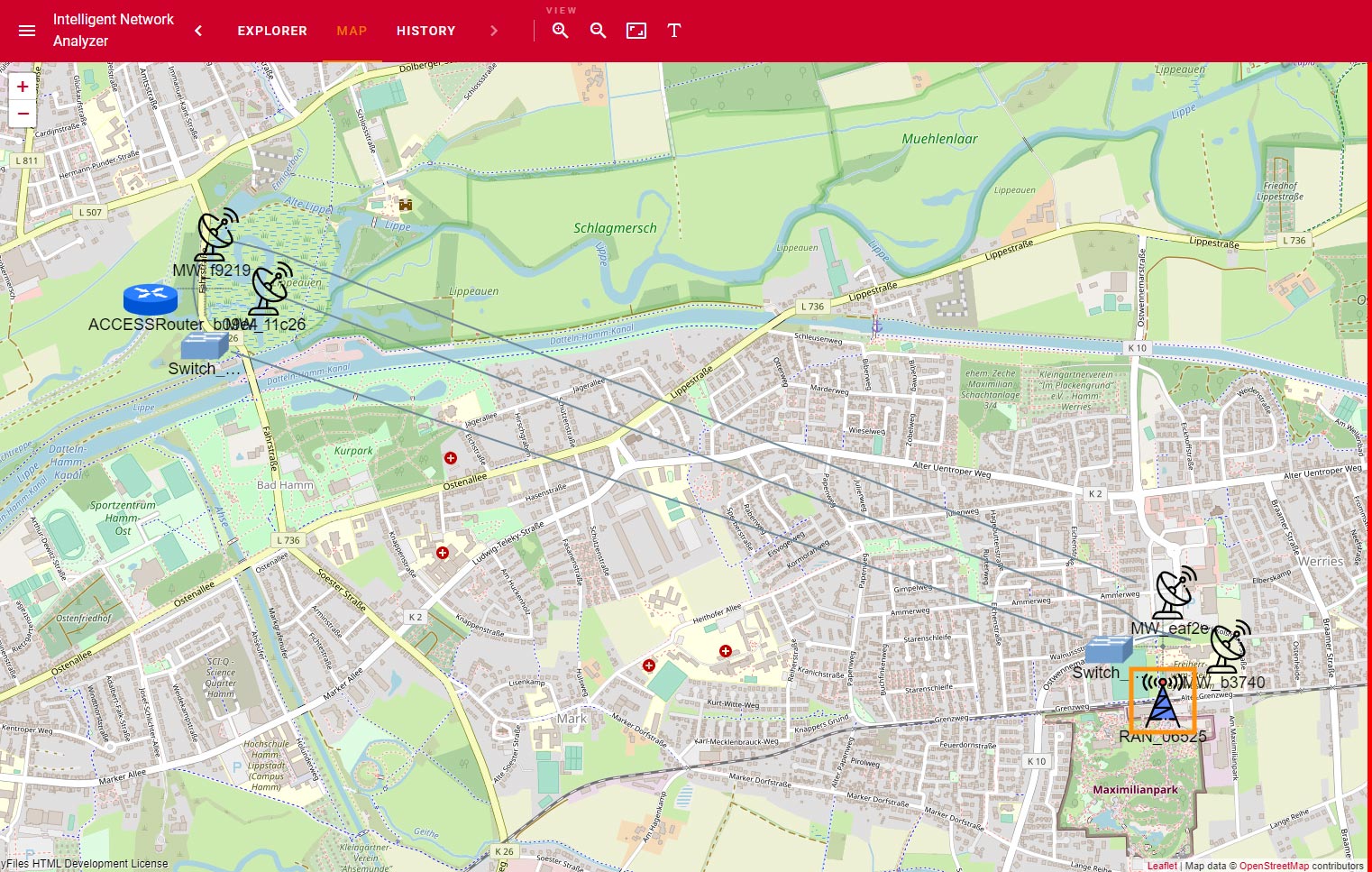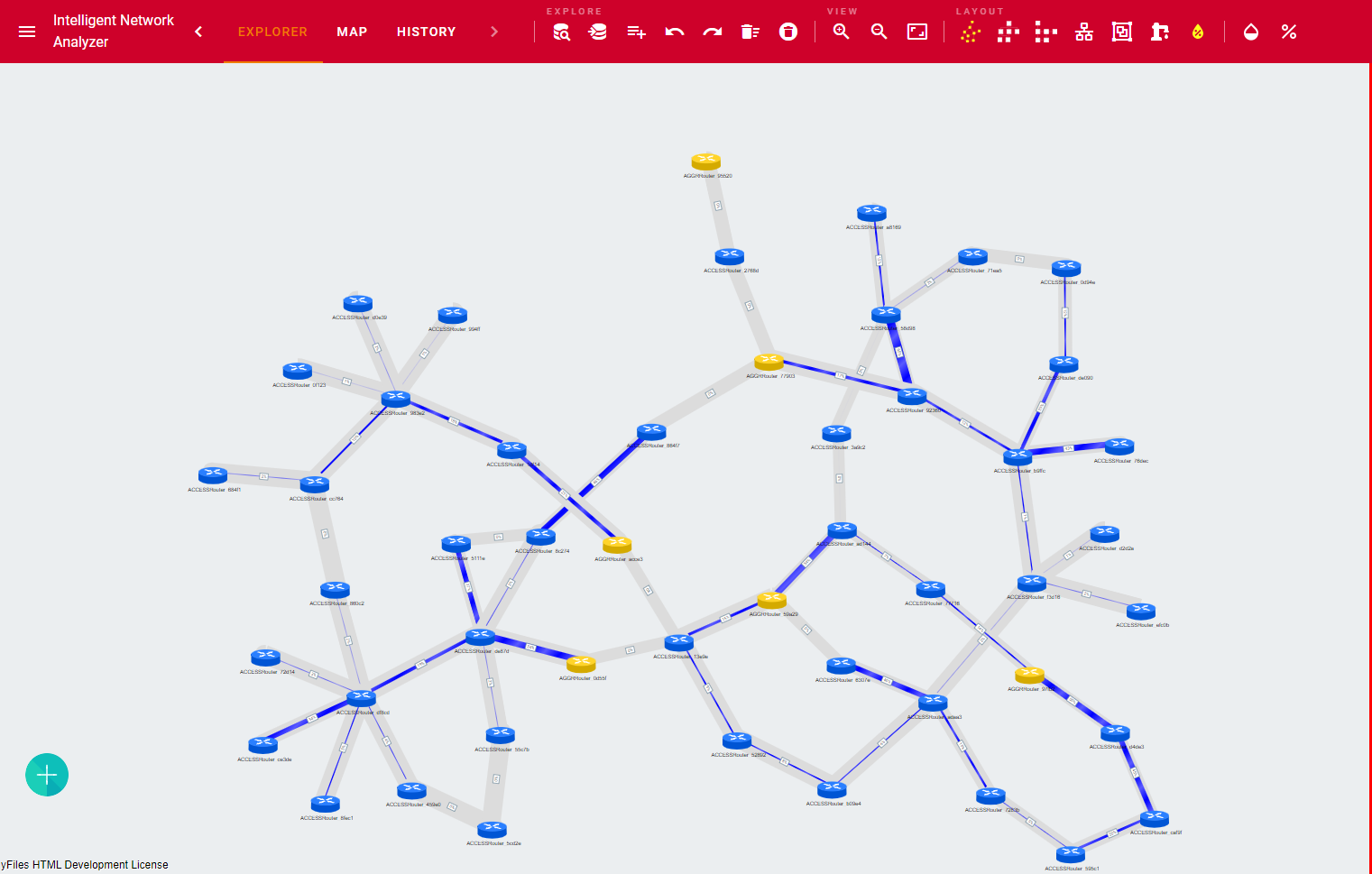Nachgefragt
bei der Data-Science-Beraterin Michele Korosec zu intelligenter Netzwerkanalyse (INA) für Telekommunikationsunternehmen
(click here for an english version)
Plötzlich kein Internet, Schwankungen bei der Mobilfunkverbindung oder temporär geringere Bandbreiten kennt jeder aus dem Alltag. Ein Team von Sopra Steria hat eine Analysesoftware
(INA = Intelligent Network Analyzer)entwickelt, mit der sich Netzbetreiber ein virtuelles Ebenbild (Digital Twin) ihres Netzes schaffen und so Netzkonfigurationen und ihre Auswirkungen vorab simulieren können. Michele Korosec aus unserem Telecommunications-Team begleitet die Implementierung bei einem großen Telekommunikationsunternehmen. Im Interview berichtet sie, wie sich die Zahl der Netzausfälle so deutlich reduzieren lässt.
Michele, wieso kommt es immer wieder zu Störungen im Netzbetrieb von Telekommunikationsunternehmen?
Das passiert, weil an den Netzen ständig herumgebaut wird, wie am Kölner Dom, der auch nie wirklich fertig wird. Router werden erneuert, Netze auf Glasfasertechnik umgestellt, der neue 5G-Mobilfunkstandard ausgerollt, damit wir alle noch schnelleres Internet bekommen, und diverse andere Dinge. Es kann beispielsweise sein, dass der Vermieter eines Standorts für einen Mobilfunkmast den Vertrag kündigt und der Netzbetreiber nun einen neuen Standort einrichten muss, inklusive aller Baumaßnahmen und technischen Anpassungen an die Netzverbindungen und Knotenpunkte. So ein Netz wird also nie fertig.
Das alles geschieht im laufenden Betrieb, wie wenn wir bei voller Fahrt einen Autoreifen wechseln. Telekommunikationsunternehmen können nicht rechts ranfahren und das Netz kurzzeitig abschalten, wenn sie daran etwas ändern wollen. Dafür ist das System zu komplex. Das Netz eines typischen Mobilfunkbetreibers in Deutschland besteht aus zirka 30.000 Routern, 50.000 Richtfunkverbindungen und 80.000 Endpunkten. Alles ist miteinander verknüpft. Eine Anpassung in Norddeutschland kann sich auch tief im Süden auswirken.
Telekommunikationsunternehmen verändern ihr Netz rund tausendmal am Tag. Dabei passieren Fehler, die auch ein Netz lahmlegen können. Verursacher sind dabei in den seltensten Fällen Bagger, die Kabel beschädigen. Etwa 80 Prozent der Netzausfälle basieren erfahrungsgemäß auf technischen Anpassungen und Konfigurationen am Netz.
Wie behalten Netzbetreiber den Überblick?
Durch eine Dokumentation des Netzes. Die Betreiber tragen sämtliche Bestandteile und Verbindungen in einen Netzplan ein. Aber, und das ist der Knackpunkt: Diese Dokumentation des Netzes ist nicht vollständig synchron mit dem Netz. Die Betreiber haben kein exaktes Abbild der Netzrealität, wenn sie Erweiterungen und Rekonfigurationen planen. Kleine Unterschiede können in einem so stark vernetzten System jedoch große Auswirkungen haben – schlimmstenfalls: kein Internet oder Telefon für Kundinnen und Kunden in einer bestimmten Region.
Der Prozess der Netzaktualisierung ist durchaus professionell organisiert, läuft aber eben nicht synchron mit dem Netz. Wenn viele Projekte in Deutschland parallel laufen, entstehen Abhängigkeiten zwischen dem tatsächlichen Netz und den Änderungsprojekten, die vom Planungssystem vielfach nicht richtig erkannt werden. Durch die Informationslücke in der Netzdokumentation können Projekte zum Teil nicht effizient bearbeitet werden.
Übertragen auf den Straßenbau: Es kann sein, dass eine Straße nicht mehr da ist, ich sie aber als Kreuzungspunkt eingeplant habe. Das begünstigt wiederum Behinderungen und Staus im Netz und ist darüber hinaus
äußerst ineffizient.
Diese Informationslücke schließen Telekommunikationsunternehmen nun mithilfe von INA. Wie funktioniert das?
Im Prinzip fragen wir das Netz, wie es gerade aussieht und funktioniert. Wir extrahieren dazu eine riesige Menge an Detailinformationen aus dem Netz, so dass ein virtuelles Abbild entsteht, ein digitaler Zwilling (Digital Twin). Sämtliche abgefragten Informationen aus dem Netz setzen wir zusammen. Dazu bieten sich so genannte Graph-Datenbanken an. Wir nutzen hierfür Neo4j, den Marktführer für Graph-Datenbanken.
Genau von hier an wird es dann „intelligent“, denn es wird definiert, wie man die einzelnen losen Enden zusammensetzt. Informationen aus mehr als 60 Datenquellen-Typen und mehr als 100 Geräte-Typen müssen in Einklang gebracht werden. In den digitalen Zwilling fließen unter anderem Konfigurationsdaten von Geräten, so genannte MAC-Adressen, Messdaten zur Performance und zur Last, Daten zu Knoten, Routern, Basisstationen sowie Switches und viele mehr.
Das Update wird täglich geladen. Im Ergebnis entsteht ein riesiger Graph, im Fachjargon Topologie genannt. Telekommunikationsunternehmen schaffen sich dadurch ein virtuelles Ebenbild ihres Netzes, und zwar genau so, wie es sich derzeit darstellt.

Kleiner Ausschnitt aus einer Netztopologie
Wie profitieren Netzbetreiber von diesem digitalen Zwilling und INA?
Die zwei größten Mehrwerte sind die erweiterten Analysefähigkeiten und die Möglichkeit, am Digital Twin zu testen und so Störungen und Ausfälle im Netzbetrieb signifikant zu senken. Daraus ergibt sich eine Fülle von praktischen Anwendungen.
Das Telekommunikationsunternehmen weiß zunächst deutlich mehr über den tatsächlichen Status des Netzes und über Auswirkungen von Veränderungen. Es kennt nicht nur den Status der Knoten und Verbindungen, sondern auch den Datenverkehr. Wir haben in INA einen vereinfachten Mechanismus eingebaut, um die Verkehrsführung zu simulieren. So kann im Vorfeld geprüft werden, welche Auswirkung eine geplante Änderung hat. Zudem soll sich künftig der Graph aktualisieren, wenn ein Techniker draußen einen Standort kurz „stromlos“ schalten muss. Diese Veränderung und ihre Auswirkungen bekommen die Netzbetreiber deutlich schneller mit.
Darüber hinaus lassen sich die kürzesten Verbindungen, gewichtet nach Bandbreite, ermitteln, um den Datenverkehr so zu routen, dass keine Überlastung entsteht – praktisch wie ein Staumanagement. Dabei muss teilweise die beste Option aus Billionen Möglichkeiten gefunden werden. Alle Varianten durchzuprobieren würde 25 Jahre dauern bei einer Millisekunde f
ür jede Konfiguration. Mit einem Verfahren, das Simulated Annealing heißt, können wir das in zirka einer Minute berechnen. Nach rund 1.000 getesteten Varianten haben wir ein vertretbares Ergebnis.
Um Veränderungen zu simulieren, lässt sich eine so genannte Impact-Analyse durchführen und so ermitteln, wie sich Fehler auf die gesamte Netz-Topologie auswirken. Wir können beispielsweise herausfinden, was passiert, wenn ich einen Standort abschalte, oder ob ich bestimmte Router nicht abschalten kann, ohne dass das Netz beeinträchtigt wird. Das Unternehmen stellt so unter Umständen fest, dass es auf Hardware verzichten kann, und spart damit Kosten und Energie. Letzteres kommt nicht nur dem Netzbetreiber zugute, sondern unterstützt das Erreichen von Nachhaltigkeitszielen.
INA dient somit ebenfalls der wirtschaftlichen Entscheidungsfindung, weil sich jede Veränderung im Netz auch aus Kostensicht analysieren lässt. Wenn der Bau einer optimalen Routerverbindung beispielsweise zu lange dauert, kann stattdessen eine weniger optimale, dafür aber schneller umsetzbare Lösung realisiert werden.
 Digitaler Zwilling eines Telekommunikationsnetzes (Ausschnitt)
Digitaler Zwilling eines Telekommunikationsnetzes (Ausschnitt)
Und was machen die Experten und Netzspezialisten, wenn INA ihnen die Arbeit abnimmt?
Diese Menschen sind heute noch wichtig, weil sie die datenbasierte Lösung bewerten und ihre Expertise beisteuern, um die Software noch besser zu machen. INA ist der elektronische Berater, der dem Netzplaner/den Netzbetreibern hilft, eine noch bessere Entscheidung zu treffen. Zudem ist INA ein Werkzeug, kein Automat. Im aktuellen Projekt arbeiten rund 400 User mit der Software, bis zu 60 gleichzeitig.
Zum Schluss: Ist INA ein Ansatz allein für die Telekommunikationsbranche oder können andere Branchen ebenfalls profitieren?
Generell lässt sich INA nicht nur in Telekommunikationsunternehmen verwenden. Überall dort, wo hochkomplexe Netzwerke analysiert werden müssen, sind Anwendungen denkbar. Ich kann mir das beispielsweise für die Smart Grids der Energieversorger vorstellen oder für die Optimierung von Verkehrsströmen.
Vielen Dank für das Gespräch, Michele!
__________________

Michele Korosec ist Data Science Consultant bei Sopra Steria im Team Telecommunications.
Die Physikerin begleitet derzeit die Einführung der Software INA (Intelligent Net Analyzer) bei einem großen Telekommunikationsunternehmen.
Read here the full interview in English
“Telecommunications providers can’t pull over and briefly shut down the network whenever they want to make changes.”
Checking back with Data Science Consultant Michele Korosec tells us all about Intelligent Network Analysis (INA) software for telecommunications providers
Unexpected internet outages, unstable mobile data connections, temporarily lower bandwidth. We have all experienced these disruptions in our daily lives. A team from Sopra Steria has developed an analysis software (INA = Intelligent Network Analyzer) enabling network operators to build a virtual image of their network, the digital twin, to simulate network configurations and its impact well in advance. Michele Korosec, a member of our telecommunications team, supports the implementation of INA at a large telecommunications provider. In this interview she explains how INA reduces the number of network failures significantly.
Michele, why do disruptions in network operations of telecommunications providers happen repeatedly?
They happen because networks are constantly being changed. Comparable to Cologne Cathedral. Neither the cathedral nor this kind of network will ever be finished. Routers are being renewed, networks are being converted to fiber-optic technology and the new 5G mobile communications standard is being rolled out to ensure we all benefit from even faster internet connections and many other things. The landowner of a cell tower site may, for instance, cancel the contract. So, the network operator has to launch a new site, including all construction work and technical adjustments of network connections and nodes. A network like this will never be finished.
And all of this happens during operation. It’s like changing a car tire at full speed. Telecommunications providers cannot pull over and briefly shut down the network whenever they want to make changes. The system is just too complex for that. The network of a typical mobile operator in Germany consists of approximately 30,000 routers, 50,000 microwave links and 80,000 antennas. Everything is interconnected. Any adjustment in the north of Germany may have an impact deep in the south.
Telecommunications providers change their network about one thousand times a day. In this process errors occur resulting in the shutdown of a network. Those errors are rarely caused by excavators damaging cables. Approximately 80 percent of all network failures are rather caused by technical adjustments and network configurations.
How do network operators keep track?
By documenting the network. Operators enter all components and connections into a network plan. But, and that is the crunch point: this network documentation is not one hundred percent synchronized with the network. Operators do not have an exact image of the network reality when planning extensions and reconfigurations. But even small differences can have a huge impact on this type of highly connected system – in the worst case: no internet or telephone connection for customers in a specific region.
The process of updating the network is definitely organized professionally but does not run in sync with the network. Whenever a myriad of projects run in parallel across Germany, dependencies arise between the actual network and the change projects and are often identified incorrectly by the planning system. Due to the information gap in network documentation, some projects cannot be processed efficiently. Translated to the world of road construction: the road I wanted to use as a junction no longer exists. Network obstructions and congestions are facilitated, and network inefficiency is extremely high.
Telecommunications providers are closing the gap with INA. How does it work?
We basically ask the network how it looks and functions at the very moment. We extract a huge amount of detailed information from the network to create a virtual image, the digital twin. We compile all information retrieved from the network. And use so-called graph databases for this purpose, i.e., Neo4j, the leader in graph technology.
Right from this point on it gets “smart”. INA defines how to tie up the loose ends. Information from more than 60 data source types and over 100 device types are aligned. Configuration data from devices, so-called MAC addresses, performance and utilization measurement data, data about nodes, routers, base stations, switches and much more are fed into the digital twin.
The update is loaded daily. The result is a huge graph
referred to as topology in technical jargon. Telecommunications providers build a virtual image of their network that accurately reflects its current state.
 Caption: Small detail of a network topology
Caption: Small detail of a network topology
How do network operators benefit from the digital twin and INA?
The two biggest added values include extended analysis capabilities and the ability to use the digital twin for testing to significantly reduce interruptions and outages of network operations. This results in a wealth of practical applications.
Telecommunications providers initially know much more about the actual network status and the effects of changes. They don’t only analyze the status of nodes and connections but the status of data traffic as well. We have integrated a simplified mechanism into INA to simulate traffic routing. Providers benefit from being able to check the impact of any proposed changes in advance. In future, the graph will also update whenever a field technician is compelled to switch off the power supply of a site for a short time. Network operators will notice this change and be aware of its effects much faster.
In addition, we identify the shortest connections, weighted by bandwidth, to route data traffic in such a way that network congestions are avoided. It’s basically like managing traffic jams. And it’s imperative to detect the best option from trillions of possibilities. Trying out all variants would take 25 years given one millisecond for each configuration. The so-called Simulated Annealing algorithym enables us to perform this calculation in approximately one minute. After testing as little as 1,000 variants justifiable results are obtained.
A so-called impact analysis is performed to simulate changes and identify how errors affect the entire network topology. We are able to detect, for instance, what happens if a site is shut down, or determine if certain routers cannot be switched off without impairing the network. The company may establish that no hardware is required and thus saves costs and energy. Network operators not only benefit from reducing resources but also support the achievement of sustainability objectives.
INA consequently supports economic decision-making because any change in the network can also be analyzed from a cost perspective. If building the perfect router connection takes too long, for instance, a less perfect solution can be used instead and implemented much faster.
 Caption: The digital twin of a telecommunications network (detail)
Caption: The digital twin of a telecommunications network (detail)
And what do experts and network specialists do once INA performs their job?
They are still important today. Because they are the ones who evaluate the data-based solution and contribute their expertise to making the software even better. INA is the digital consultant helping network planners and operators take even better decisions. Plus, INA is a tool, not a machine. Approximately 400 users are currently working on the software as part of the project, up to 60 at a time.
Last but not least: Is this approach restricted to the telecommunications industry or will other industries also benefit from INA?
INA is, in general, not limited for use with telecommunications providers. Applications are possible wherever highly complex networks need to be analyzed. One scenario, for instance, are smart grids operated by energy providers or the optimization of urban traffic flows.
Thank you very much for the interview, Michele!
______________

Michele Korosec holds the position of Data Science Consultant with Sopra Steria on the Telecommunications Team. The physicist currently supports the launch of the INA (Intelligent Net Analyzer) software at a large telecommunications provider.